

Critical thinking in children: Are we teaching our kids to be dumb? © 2008 - 2014, Gwen Dewar, Ph.D., all rights reserved In his review of critical thinking research, Stephen Norris wrote that critical thinking in children is uncommon: “Most students do not score well on tests that measure ability to recognize assumptions, evaluate arguments, and appraise inferences" (Norris 1985).
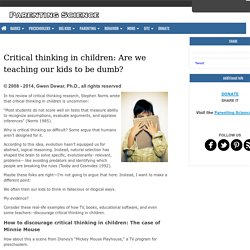
Why is critical thinking so difficult? Some argue that humans aren’t designed for it. How to think, not what to think. Thou shalt not commit logical fallacies. Three Habits Of The Most Creative Problem Solvers. Some people are better at getting out of tough challenges than others.
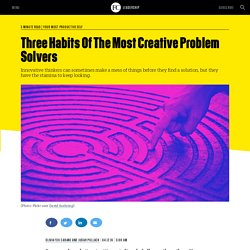
Many of them, at least in our experience, are entrepreneurs. But all of them are creative, innovative thinkers. That doesn't mean they're easy, though. In fact, the problem-solving process is often messy and chaotic, but it's usually rescued by three key habits that this type of person tends to draw on when the stakes are highest. 1. To understand them, it helps to crack open a childhood picture book, The Cat in the Hat Comes Back. That's when the Cat in the Hat shows up again (this being the sequel). Forced to abandon their objective, the children run into the house to discover the Cat in the Hat taking a bath with the shower running while eating cake. Learning Styles. Along with Multiple Intelligences, I also have them do a Learning Style surveyPage 8 Learning Style Survey This page is a survey that the kids take to identify what their personal learning style is.

The survey is split into three parts (visual, auditory, kinesthetic). They read each statement and mark it with a 0 if the statement does not apply to them, a 1 if the statement sometimes applies to them, and a 2 if the statement strongly applies to them. When they are done with each section the add up their numbers.Underneath the survey, the kids tape down a page of learning style suggestions. Reading 2.0. Many educators are worried about how technology is affecting the amount of reading that students are doing.
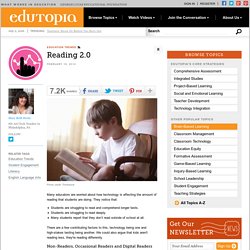
They notice that: Students are struggling to read and comprehend longer texts.Students are struggling to read deeply.Many students report that they don’t read outside of school at all. There are a few contributing factors to this, technology being one and high-stakes testing being another. We could also argue that kids aren't reading less, they're reading differently. Non-Readers, Occasional Readers and Digital Readers. Your paper brain and your Kindle brain aren't the same thing. Would you like paper or plasma?
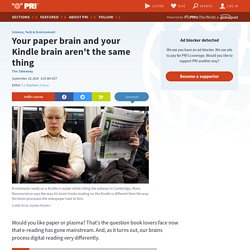
That's the question book lovers face now that e-reading has gone mainstream. And, as it turns out, our brains process digital reading very differently. Why Read Fiction? We often hear friends ask why they should read fiction.

Reading Fiction Improves Brain Connectivity and Function. The Surprising Power of Reading Fiction: 9 Benefits. “There is no doubt fiction makes a better job of the truth.” ― Doris Lessing One of the most inspiring perks we’re lucky enough to have at Buffer is a free Kindle for each teammate (and her family!)

And as many free Kindle books as you like, no questions asked. When we share what we’re reading at Buffer on our Pinterest page or in our Slack community, the selections often tend to skew more toward non-fiction—you can generally find teammates reading books that help us improve at our jobs, understand our world better and become more productive, for example. What’s interesting—and maybe a bit counterintuitive—is that reading fiction can provide many of those same self-improvement benefits, even while exploring other worlds through stories that exist only in the mind. In fact, the practice of using books, poetry and other written words as a form of therapy has helped humans for centuries. Three Cognitive Benefits of Reading Fiction. Recently, Noel Gallagher, the frontman of the band Oasis, (I didn’t know who he was either) lashed out against fiction, saying, “I only read factual books.

I can’t think of … I mean, novels are just a waste of f–king time.” Though we’re all entitled to our opinions, I was perturbed to see such a complete and disrespectful dismissal of a pastime that has enriched the lives of countless humans for hundreds of years. I wondered how many others feel similarly. TEDTalk: How Books Can Open Your Mind. The Old Schoolhouse Magazine - December 2012. The Joy of Teaching. Reading with a pen in hand.
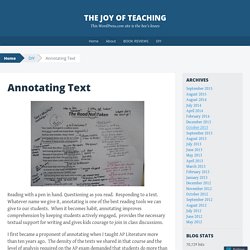
Questioning as you read. Responding to a text. Whatever name we give it, annotating is one of the best reading tools we can give to our students. When it becomes habit, annotating improves comprehension by keeping students actively engaged, provides the necessary textual support for writing and gives kids courage to join in class discussions. The AoW: A Way to Work Nonfiction Into Your Instruction - The "Real" Deahl. Each school year, I like to implement a few new ideas into my practice.
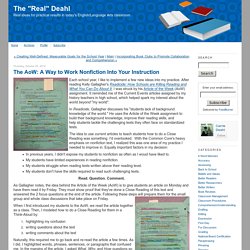
After reading Kelly Gallagher's Readicide: How Schools are Killing Reading and What You Can Do About It, I was struck by his Article of the Week (AoW) assignment. It reminded me of the Current Events articles assigned by my history teachers in high school, which helped spark my interest about the world beyond "my world". In Readicide, Gallagher discusses his "students lack of background knowledge of the world. " He uses the Article of the Week assignment to build their background knowledge, improve their reading skills, and help students tackle the challenging texts they often face on standardized tests. The idea to use current articles to teach students how to do a Close Reading was something I'd overlooked.
Annotate Novels With Sticky Notes. It's already 2014?!? Quite a bit into 2014, actually! Close Reading and Written Conversations. One of the things that I did this year that was successful in getting the kids to dig a little deeper into what they were reading was a "Written Conversation". I got this idea from the book Texts and Lessons for Content-Area Reading . I have been using it quite a bit to help ease me into this idea of "close reading" and I am loving it!
It is definitely a higher level book, as it is written for middle school, so I wouldn't recommend it for anything lower than 5th. Close Reading Picture Books. When we think of close reading, we most often think about dense passages that, at first glance, seem like they require a magnifying glass, if not a sturdy pair of reading glasses, to analyze. But, the goal of close reading is not to read and analyze as many words as possible, but to engage in critical thinking about a text and its ideas.
And, particularly in elementary school, that includes illustrations. Illustrators make many of the same choices authors make. They draw with purpose and create scenes and images that convey the arc of a narrative as well as the story’s deeper meaning. Teaching in Room 6: Digging in to Find Evidence. We have been really focusing on finding evidence and supporting our answers during our reading of Bridge to Terabithia . Our discussions, though very lively and thought provoking, have been lacking the "back up" of the book.
The students seem to know what they want to say, and are sticking with the plot of the book, but actually going back into the book and finding where they came up with the answer is a bit tricky. So this past week we did something that really got the kids digging into the book and looking at their evidence. I think it was pretty successful, so I thought I would share with you. I gave the students four questions to answer about the chapter (if you are reading Bridge, it was questions dealing with chapter 7) Then, in groups, I asked them to answer the questions, citing at least three different references from the book. Text-Based Opinion Posters. Kids form opinions on everything they encounter rather easily. The know what they like and what they don't like in an instant. Socratic Seminar. The Socratic style of discourse lends itself quite well to establishing critical thinkers due to the fact that Socrates believed that enabling students to think for themselves was more important than filling their heads with knowledge.
With so much talk about the Common Core standards and truly increasing our student's argumentative powers and critical thinking skills, I decided to launch a Socratic Seminar style of instruction in my sixth grade classroom this week. Socratic Smackdown. Making Meaning with Melissa: Why I Use Mentor Sentences to Teach Writing in my High School English Classroom. This fall marks the sixteenth year that I will be returning to school as an English teacher.
How to Write an Effective Essay: The Introduction. Socratic Seminars: Patience and Practice.